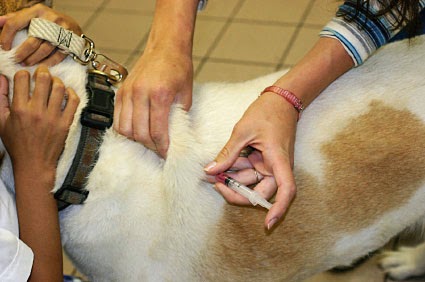November is National Pet Diabetes Month. We wanted to share with our pet parents ways to increase awareness about this disease that is growing among pets.
Here’s some information about the two different types of Pet Diabetes followed by 10 warning signs to look out for with your pet.
In veterinary medicine, there are two types of diabetes mellitus: Type I DM and Type II DM.
Type I DM is when the body doesn’t make enough insulin (which is a hormone that is normally produced from the pancreas), and requires life-long insulin therapy (delivered via a syringe twice a day). This is most commonly seen in dogs – in other words, once a dog becomes a diabetic, he or she is diabetic for life.
Type II DM is when the body has some insulin being produced from the pancreas, but it is an inadequate amount or something is interfering with its ability to be used by the body. This is most commonly seen in cats and can be transient. In other words, if your cat has recently been diagnosed with Type II DM, he or she may only need insulin injections (via a syringe twice a day) for a few months to years, not necessarily for life.
Here are 10 diabetes warning signs to look out for with your pet ::
#1 Increased Thirst
Drinking more water than usual (known as polydipsia) is an early sign of diabetes.
#2 Increased Urination
Urinating more than usual throughout the day, or having accidents in the house may be another tell tale sign of diabetes called polyuria, which goes hand in hand with polydipsia.
#3 Increased Hunger
If your cat or dog suddenly acts as if it is always starving, despite eating the usual amount (known as polyphagia), and maintains or loses weight despite the increased food intake, can also be a sign of diabetes.
#4 Sudden Weight Loss
Though a diabetic pet may show signs of being hungrier than ever, sudden weight loss is a common occurrence because diabetes can cause an increased metabolism.
#5 Obesity
Obesity can actually cause diabetes to develop; therefore if your pet is obese you should keep an eye on them to determine if they are developing any symptoms of the disease.
#6 Weakness or Fatigue
Diabetes can cause wasting of back muscles or weakness in the back legs of cats. With dogs there may be a general sense of lethargy, less activity, or sleeping more than usual.
#7 Thinning or Dull Hair
Thinning, dry, or dull hair, particularly along the back. Thinning hair is generally a symptom of some illness, diabetes included. So it is best to visit your veterinarian to determine the cause.
#8 Cloudy Eyes
A common complication of diabetes in dogs is cataracts, or cloudy eyes. This should be closely monitored as cataracts can lead to blindness if not taken care of.
#9 Depression
A later sign of diabetes in dogs and cats is ketoacidosis, metabolic acidosis caused by the breakdown of fat and proteins in the liver in response to insulin deficiency. Ketones in the body in high amounts are toxic, and this imbalance in your pet’s body can cause depression.
#10 Vomiting
Another side effect of ketoacidosis (if your pet’s diabetes has escalated to this point before it’s been recognized) is vomiting. Ketoacidosis is more commonly found in older pets and in females. Dachshunds and Miniature Poodles are also predisposed to it.





